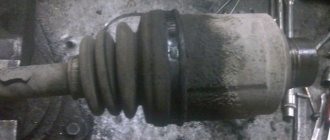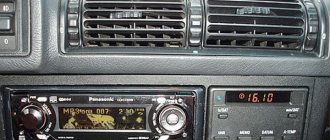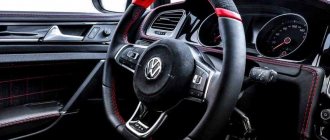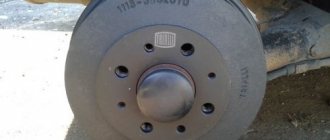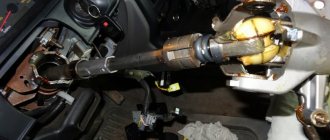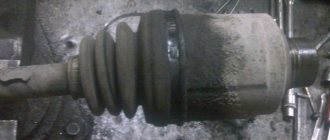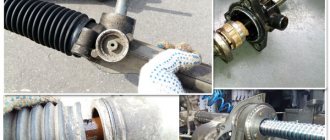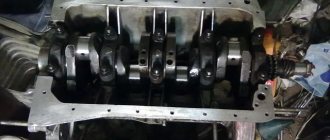Many car enthusiasts have encountered vibration, or, as it is also called, steering wheel knock. A slight vibration can be considered normal, but a knock that strongly resonates in the hands cannot be called normal. In fact, steering wheel vibration may indicate problems that are not directly related to the steering mechanism. As is the case with almost all automotive mechanisms, ignoring the problem can have serious consequences. Let's figure it out and at the same time study how problems can be prevented.
When the driver feels vibration in the steering wheel
Practice shows that almost all car owners are familiar with the problem of steering wheel wobble. However, there are several situations in which this same beating can be observed. And here are the situations we are talking about:
- Car braking;
- Sharp turns on bumpy roads;
- Measured movement at low speed;
- Movement at very high speeds - from 80 kilometers per hour and above.
As you can see, completely different situations are listed. They need to be disassembled separately, which is what we will do now. Let us immediately note that such a problem cannot , and it is usually solved quite quickly .
Although diagnostics and purchase of spare parts or tires can cost a pretty penny, the expenses are justified by the safety and comfort of further driving.
Engine mounts, tie rods and other problems
There is another group of problems that cause vibrations when accelerating a car. It is difficult to collect these problems into one bundle, because they are all different and arise for various reasons. Vibration often occurs when one of the engine mounts is broken. This can easily be checked by increasing the speed while shaking.
The gearbox may also be the culprit for this type of problem. If the car starts to shake at 80 kilometers per hour, you can very easily check the fault of the gearbox by performing the following procedures:
- accelerate to a speed of about 85 kilometers per hour;
- depress the clutch and observe the vibration change;
- engage third gear and smoothly release the clutch;
- try accelerating from 50-55 kilometers per hour in last gear.
If the nature of the shaking does not change in all these experiments, the box has nothing to do with this problem. If there is more shaking when the gearbox is engaged, you will have to check whether it is involved in this problem.
You can also check the automatic transmission. At a speed of about 85-90 kilometers per hour, it is enough to switch the gearbox selector to modes 3, 2, D, N and observe the operation of the box itself and the change in vibrations. Often the gearbox is not to blame for the vibration of the car body, but there are such cases.
For useful tips on some possible causes of shaking, watch the video:
Vibrations at high speeds
At speeds above 80 kilometers per hour, the steering wheel may shake noticeably. As a rule, the beats become especially strong from 100 kilometers per hour. And the point is this: when the mass of the wheels at different points is not aligned (the wheels are not balanced), the so-called centrifugal force that pulls one of the wheels along with it. The driver feels this when holding the steering wheel - it begins to vibrate strongly. But that's not all! As practice has shown, the action of centrifugal force is, as it were, reinforced by a number of other factors. Among them:
- Deformation of wheel rims . Typically, steering wheel wobble is observed due to mechanical damage to discs that have been in use for a long time. In rare cases, discs may already have a defect from the factory - if you notice this initially after purchase, be sure to return the discs to the seller;
- Tire surface deformation . Namely, the side surface. This deformity is also called a hernia. Pay attention to each of the wheels - if at least one tire has a clearly visible bulge or a mechanical defect in general, it needs to be replaced;
- Wheel bearing failure . If the wheel bearing fails, the wheel will not rotate smoothly. The driver will be able to feel this through the steering wheel;
- Weak tire inflation . Usually, poorly inflated wheels do not make themselves visible through the steering wheel - the whole car begins to vibrate - but it is simply impossible not to mention such a problem.
Spare parts for Chevrolet aveo
Motor oil
AVEO sedan (T250) (05.05 — )
Spare parts for Chevrolet lacetti
Motor oil LACETTI sedan (J200) (03.03 — )
Try to pick up speed and make sure that the steering wheel shakes when moving quickly. Then stop and carefully inspect the tires. Next stage: checking the wheel bearing, balancing the wheels. Please note that defective tires can cause steering vibration even if the wheels are perfectly balanced. Also, when visiting a workshop, we recommend that you draw the specialist’s attention to the issue of correct wheel installation .
In some cases, the installed hubs simply do not fit the rims. The unfortunate craftsmen could also have incorrectly tightened the wheel bolts or nuts with conical bases.
The engine vibrates strongly at idle: possible reasons
The normal operation of a serviceable motor requires minimal vibration, which is quite acceptable. It should also be taken into account that in the cold season the engine may vibrate somewhat more strongly. After 3-5 minutes of warming up, the vibration level should return to normal. In parallel with this, there should be no jerks, dips or omissions, as well as extraneous sounds in the engine operation.
The appearance of noticeable vibrations indicates that certain malfunctions are possible. Let us immediately note that increased vibrations are detrimental to the internal combustion engine, so such a problem must be diagnosed and eliminated as quickly as possible.
Among the main reasons why the engine begins to vibrate (shudder, twitch) at idle, experts identify the following:
- engine troits;
- problems with the correct mounting of the motor;
- faulty engine mounts;
- crankshaft imbalance;
For normal operation of the power unit, idle speed is usually around 750-950 rpm, which depends on the type of engine. Reducing the idle speed will cause the engine in this mode to start running less stable and may even stall at idle. An increase in speed naturally leads to increased fuel consumption, as well as an increased load on the CPG and other components of the internal combustion engine. As a result, motor life is reduced. For this reason, an optimal balance is maintained for each engine to achieve maximum efficiency and stability at idle.
Motor troits
If the engine starts to stall, then uneven operation of the cylinders is observed. The most severe engine vibration at idle is felt if one of the cylinders is not working. Pressing the gas pedal allows you to partially compensate for the resulting imbalance by increasing the crankshaft speed, but engine power will still be reduced.
The load on the crankshaft when the cylinder is not working or is misfiring remains uneven, which causes jerking and jerking of the engine. The driver usually feels a noticeable shudder and vibration in the steering wheel, which can also be transmitted to the body. The engine vibrates most strongly at idle, and also under load when driving at low speeds.
It is necessary to eliminate the problem with an inoperative cylinder as quickly as possible, since in addition to vibrations that destroy the engine, normal fuel combustion does not occur in the combustion chamber of the problem cylinder. As a result, excess fuel washes away the lubricant from the walls of the faulty cylinder, thereby increasing wear on its mirror. Also, on worn-out engines, there is a high probability of unburned fuel leaking through the seals, which leads to fuel getting into the engine oil and losing its beneficial properties. In this case, the engine wears out faster, cokes more, etc.
Additionally, it is worth noting the engine vibrations that appeared after replacing the timing belt. In this case, it is necessary to eliminate the possibility of an error when installing the belt, since a displacement of even one tooth leads to a violation of the valve timing. The result is engine malfunctions and engine tripping.
Mounting and malfunction of engine mounts
A common problem that causes increased engine vibrations is a defect in the power unit mounts. Most often, the problem lies in the engine supports (so-called mounts), which can become unusable over time. These pillows are a kind of dampers that not only hold the internal combustion engine, but also dampen vibrations.
Also, an increase in the level of vibrations can occur after replacing one or more pillows with products with greater rigidity.
You can diagnose the problem as follows. Invite an assistant and open the hood, then rock the car with sharp jerks by moving the car forward and backward. The assistant must record the angle and degree of engine deflection during such rocking. Normally, the engine should swing forward, backward, and also to the sides evenly and equally.
If deviations are detected, that is, the motor has a greater tilt in one direction, the corresponding motor mount will need to be replaced. Please note that experts recommend replacing engine mounts even if there are no visible defects or damage on the part itself. Also, after replacing the support, it is necessary to carefully adjust.
Balancing the crankshaft and CPG
During the process of repairing an internal combustion engine, which involves grinding or replacing the crankshaft, it is necessary to subsequently balance the part with the flywheel and clutch. To balance the crankshaft, specialists drill out extra grams in its body. It is also necessary to weigh the pistons, piston pins and other parts of the CPG before assembling the engine. Differences in the weight of parts can cause a serious increase in vibrations.
We also recommend reading the article about why a gasoline engine can sound similar to a diesel engine. From this article you will learn about the reasons for the appearance of extraneous sounds and noises in the operation of a gasoline internal combustion engine.
Steering wheel vibration at low speed
Not the most common problem, because, according to statistics, drivers more often complain about steering wheel vibrations at high speeds. However, from these statistics we can glean something very interesting: car owners are more likely to experience problems of this nature in the winter . If the steering wheel starts to shake at low speed, you should think about the following:
- Have the wheel rims collected a large amount of dirt? It may not sound very plausible, but dirty rims can cause steering wheel vibration. The same applies to snow and ice stuck to the discs;
- Are the wheel bolts properly tightened? The classic cause of steering wheel vibration;
- What condition are the ball joints in? As a rule, heavily worn ball joints cause the steering wheel to wobble when accelerating;
- Is there any deformation of the discs? Vibration is also a very common cause. At first, the deformable discs only twitch slightly, but after a while they remind you of themselves through the steering wheel.
As you can see, the reasons are purely technical. It is enough to inspect the rims and diagnose the ball joints. We also advise you to pay attention to the engine mount. It sometimes happens that steering wheel vibrations are observed on cars with a badly worn air conditioning fan, since it constantly operates at maximum speed.
Causes of vibration
When various car parts fail, an experienced driver can immediately determine the nature of the breakdown by ear and by the sensations of driving the vehicle. Vibrations indicate a problem instantly, but the reasons for each car are unique.
Main components that should be checked:
- Wheels and tires.
- Chassis.
- Brake system.
- Transmission.
- CV joints.
- Cardan.
- Differential.
Vibration can occur for various reasons.
As soon as the slightest vibration begins to appear on the body of your car, it is worth postponing long trips and starting diagnostics. You can check the details yourself. Specialists in service centers can handle this task better. They will instantly determine the nature of the breakdown and fix it. But, as a rule, most car owners prefer to solve the problem on their own. Let's look at each of the reasons together.
Damage to the disc and tires
The majority of motorists have to travel on bad roads every day. The quality of the coating or the “lack thereof” wears out all the parts in the car structure.
The first elements that are damaged when driving through potholes are the suspension and tires with rims. Any service station employee will confirm that more than half of their customers ask for wheel or tire repair.
If there is a strong impact, a crack may form in the wheel rim. The most common type of product is stamped factory wheels. They may bend from impact. As a result, vibration from the imbalance begins to be transmitted to the steering wheel and the entire body.
Damaged tires have the same symptoms. Tire wear patterns can significantly affect vehicle handling. In addition, a common reason is deviation of the wheel alignment angles. Therefore, you should carry out the following repairs:
- Adjust the wheel alignment.
- Replace tires if severe wear or other damage is detected.
- Repair the wheel rim or replace it.
- Balance the wheels.
Suspension and chassis
The most common problem is vibration during acceleration on front-wheel drive. Why? The reason for this is that cars are equipped with a more complex type of suspension, which includes many important mechanisms. They wear out first and require timely maintenance.
As a rule, determining the source of vibrations in the suspension is quite simple. Vibration spreads throughout the body when accelerating from 20 to 40 km/h. If at low speeds you feel a slight shaking, this indicates the need to sort out the chassis.
The first thing that fails is the shock absorbers and struts. They are considered consumables among motorists on domestic roads. In general, vehicle owners, when purchasing parts, give preference to brands of medium quality - both economically and reliably. But, as practice shows, racks have to be changed more often than stated by the manufacturer.
Vibrations are accompanied by unnatural rocking of the body in the pits. The element must be replaced immediately. During repair work, you should carefully check the support bearings of the strut itself.
It also provokes vibrations and wear of the ball joint at high speeds. Drivers often mistakenly believe that such vibrations are caused by broken wheel bearings. Always check the service life of the supports and ensure that there is no play.
Brakes
This mechanism causes vibration in only 10% of cars. But, despite this, the problem is considered serious, since it is quite difficult to diagnose a malfunction of the brake mechanism yourself.
How to understand that it is the brakes that need to be repaired? When accelerating, the car body shakes slightly. An inexperienced driver may not notice the defect at first. And the determining factor is the disappearance of vibrations during braking.
In this case, check the brake disc fastenings. If the problem is not corrected in time, sooner or later the disk may become blocked while the machine is moving.
checkpoint
Many owners of both foreign and domestic cars complain about gearbox malfunctions. It can really cause characteristic vibrations.
There are several simple methods for determining the condition of the transmission. Here's one of the best:
- It is necessary to pick up speed to 80-85 km/h on a flat road.
- Depress the clutch pedal - the intensity of the vibrations may change.
- After this, you should shift to third gear and slowly release the clutch pedal.
- Accelerate the car from 50 km/h in top gear.
This approach will immediately make it clear that it is time to service the transmission. What could be the reason? One of the most common options is a rapid drop in the oil level in the gearbox. Parts begin to operate at elevated temperatures, and wear accelerates. It seems as if there is strong vibration from the engine. True, in this case it is worth checking the power plant itself.
On automatic transmissions, this problem is solved by replacing the oil filter. As a result, the body stops shaking at high speeds.
Disc damage is the most common cause of vibration
CV joint
Every driver should check this reason first. CV joints are considered the most common source of vibration. On some cars they fail more often than other parts.
When repairing, it is easy to determine the wear of an element. You need to grab the shaft and rotate it slightly in both directions. There is some play - the part needs to be replaced. If there are no vibrations in the spline joints, and vibration comes from this area, check the ball joints.
In order not to disassemble the entire mechanism, you can independently and quickly diagnose the CV joint on the go:
- Slow down or stop the car completely.
- Turn the steering wheel in the direction from which the vibration is heard.
- Start the car moving sharply;
- If you hear a crunching sound when turning sharply, replace the CV joint!
When installing a new product, be it an original part or a “high-quality” analogue, you need to carefully handle the rubber boot. It must not be damaged.
Cardan shaft
Similar problems arise in the operation of the driveshaft. Basically, this unit does not fail often, since it is a fairly reliable mechanism on any vehicle. Moreover, most manufacturers make such shafts from high-quality metal.
A cardan failure is often detected when it is running at idle. As soon as the torque is transmitted through the transmission, the car body begins to shake. The problem is typical mainly for domestically produced vehicles.
Some service centers and small workshops offer to repair the driveshaft at a reasonable price. But it is worth emphasizing that this service is more often applicable for freight transport.
Drive shafts of such equipment are easier to repair than parts of passenger cars. Therefore, if such a breakdown occurs on a sedan or station wagon, it is better to replace the cardan.
Differential
Drive mechanisms suffer greatly from poor-quality road surfaces. CV joints, gearbox gears, shafts, and differentials wear out quickly. They produce almost the same vibrations as the driveshaft.
Malfunctions of these mechanisms are accompanied by vibration both at the beginning of movement and when accelerating at high speed. Since the element is a fairly expensive part, the best way out of the situation would be to prevent wear on the differential. It needs to be lubricated on time and the car must be operated without unnecessary loads. But if fluctuations have already begun, then only comprehensive diagnostics and replacement will help.
Whenever installing a new differential, do not skimp on oils. The lubricant must be of high quality and there should not be enough of it. This way the part will last longer.
Wear of the cardan shaft cross
Steering wobbles when cornering or on bumpy roads
Everything gets more interesting here. If steering wheel beating is observed at high or low speeds, you need to check the rims, fasteners, and also balance the wheels. But if the problem occurs when turning or while driving on a poor-quality road, you need to check several elements of the chassis and steering mechanism:
- Tie rod ends . If driving on bumpy roads gives a lot of feedback to the steering wheel, you need to check the tips. In a good way, this should be done in the inspection hole and with an assistant who will turn the steering wheel while you monitor the operation of the tips. In the tips, the liners and anthers wear out first;
- Steering rack . If on bad roads the driver feels vibration that turns into clearly noticeable shocks, it is worth checking the steering rack fastening. Also check the bushing - it wears out relatively quickly;
- CV joint Everything is simple here: if the driver hears a “crunch” in the wheel area, you need to change the corresponding hinge;
- Shock absorbers . The purpose of shock absorbers is to soften shocks and increase driving safety and comfort. Sometimes drivers get used to hard shock absorbers and even begin to drive more carefully, but if the steering wheel begins to vibrate, the shock absorbers should be checked and, if necessary, replaced;
- Silent blocks . The simplest diagnosis of silent blocks on a raised car includes a visual inspection, studying the behavior of the levers when swinging, as well as listening to detect knocking noises. Experts advise immediately changing silent blocks that do not inspire confidence;
- Steering gear bearings . They often cause steering wheel vibration. If the steering gear knocks when entering a turn, and the steering wheel itself begins to vibrate noticeably, it is worth checking the thrust bearings.
As you can see, you can diagnose the suspension and steering mechanism yourself. An inspection hole or a jack, as well as the help of a second person, will be very useful here. However, we recommend contacting a service station - specialists will carry out diagnostics much faster and with better quality. As for the choice of spare parts for repairs, here it is worth giving preference either to the originals or to those manufacturers who supply their goods to automakers.
Steering wheel vibration when braking
Often the causes of beating need to be looked for in the brake system. Namely, in brake discs and pads. As all car enthusiasts probably know, brake discs get very hot during operation. The process of thermal expansion of metals, which is simply called deformation due to overheating , causes steering wheel vibration. When heated and then rapidly cooled, brake discs become wavy, and the drum simply becomes uneven. We also cannot fail to mention the problem of brake disc contamination.
Pay attention to the brake pads. After grinding in, their surface does not always become perfectly smooth. After pressing the brake pedal, due to the irregular shape of the brake pads, the brakes begin to vibrate, and this same vibration is transmitted to the steering wheel. It is also worth examining the caliper - it may press the pads against the disc unevenly, which causes vibrations. Brake calipers need to be cleaned of rust and lubricated.
Vibrations when parked and idling
Sometimes car owners complain about steering wheel vibration when idling and when trying to move away. The vibration itself can be quite strong. The problem makes itself felt especially often in used cars that have not previously been subjected to frequent repairs and replacement of individual components. Vibration at idle can be caused by any of the following:
- Wear of power unit cushions . In this case, the pillows need to be changed and, just in case, the engine itself must be checked - if it begins to vibrate after a major overhaul, a check is mandatory;
- Worn steering rack . To be precise, wear of either the entire rack drive shaft or the splined part of the shaft. The vibration of the steering wheel with such a rack will increase as the speed increases.
Only checking and replacing worn parts will help here. Remember that the rubber-metal parts adjacent to the engine do not have the longest service life and must be changed regularly. On average, their resource is 100-120 thousand kilometers. In practice, this mileage can be either significantly greater or slightly less. The resource of analogue spare parts is significantly less.
Wheel alignment and tire quality
If the wheel alignment angle is incorrect, then in this case vibration cannot be ruled out, as well as such an unpleasant moment when the car pulls to the side and tire wear occurs unevenly. The presence of this problem in different models occurs in different ways. If there is body vibration, you must first adjust the wheel alignment angle. Problems can be caused by unevenly worn tires or a disc caused by a serious impact. In this case, you can apply the following processes to get rid of body vibration:
- Adjust the wheel alignment angle at the station where wheel alignment is performed;
- Replace tires if excessive or uneven wear occurs;
- Replace or repair a disc that is characterized by unevenness and dents in the rim;
- Balance the wheels, as balancing weights often fly off during operation.
If the balancing weights have come off the wheel, vibration can be observed at speeds of 80 km per hour or more. Determining this on your own is noticeably more complicated, so you cannot send a specific wheel for balancing. In this case, it is necessary to balance all the wheels at a tire shop.
This breakdown option is one of the safest and least expensive, so you need to start by checking such faults, and then you can consider some other options as suspicious.
What are the consequences of ignoring the problem?
If you regularly hit the steering wheel while driving and you are even used to it, you should not think that the problem will not have consequences. Experienced car enthusiasts probably know that even the most wear-resistant mechanisms cannot tolerate frequent and strong vibration. It can damage almost any mechanism. It also does not have a positive effect on the driver. Please note that steering wheel vibration may increase over time. For example:
- For some reason, the steering wheel began to shake slightly. The problem is ignored;
- Tires wear out more. The beating becomes stronger;
- Bearings, suspension components, and individual elements of the steering mechanism wear out greatly. Driving a vehicle becomes much more difficult.
Experts are confident that the main problem with vibrations is the wheels, and in some cases, the brakes. The suspension of a car with a constantly vibrating steering wheel simply becomes weaker over time and its individual element may fail much earlier than expected. The danger here is that the driver of a problematic car becomes less attentive and more irritable, which, coupled with the technical shortcomings of the vehicle, can cause an accident.
Tips and tricks
As you can see, to prevent vibrations, regardless of whether the engine is carburetor or injection, it is necessary to maintain the cleanliness of the fuel system, the functionality of the ignition system, etc.
The fuel pump and ECM sensors, fuel and air filters deserve special attention; the fuel injectors, idle air valve, and accelerator pedal need to be adjusted. It is important to understand that vibrations that are not eliminated in a timely manner lead to the following negative consequences:
- cracks in the car body;
- gradual unscrewing of even the most tightly tightened nuts and bolts (which can lead to an emergency);
- premature wear of parts, resulting in, for example, oil leakage, destruction of bearings, seats, fasteners, etc.
We also note that sometimes motorists are faced with a problem such as a drop in speed to 500 rpm. on a warm engine at a rate of 750-900 rpm. As a result, the internal combustion engine begins to vibrate strongly. This indicates problems with the throttle and sensors (for example, TPS).
Also, drivers often deliberately lower idle speed to save fuel (especially if they have LPG). At the same time, the consequences of engine vibrations will subsequently lead to repairs, which in cost will cover all the savings on fuel.
Even while driving, it is important to consider at what speed to drive. The fact is that if the car is used incorrectly, vibrations can also occur. To prevent this from happening, you should adhere to the following rules:
- upshifting must be done between peak torque and peak power;
- when vibration occurs, it is necessary to switch to a lower gear to avoid engine damage;
- if the car does not pull, you must also switch to a lower gear, but do not allow vibrations to occur.
This approach will avoid premature wear of parts, while ignoring it will quickly damage engine pistons, transmission bearings, clutch basket, crankshaft liners, etc. Carbon deposits and wear appear on the walls of the cylinder liners; due to constant vibration, oil seals begin to leak, and shafts begin to run out.
Conclusion
Engine vibration can indicate many problems in various parts of the car. This includes the brake, the chassis, the steering mechanism itself, and sometimes even engine fasteners. Since vibrations only indicate something more, a car enthusiast should never ignore the problem - he needs to plan a trip to a service station and carry out repair work as early as possible. The car owner can do only a few things on his own: check the brakes and wheels, lubricate the brake mechanisms, replace the rod ends or tighten the steering rack, and also check the condition of the boots and silent blocks.
Let's sum it up
If you are unable to find the problem that is causing the body or steering wheel to vibrate in your car when accelerating, you should contact a professional. Do not leave this problem, because it can worsen and create dangerous travel conditions for the driver and passengers of the car. It is necessary to respond as quickly as possible to all possible problems and eliminate them by replacing failed machine elements.
Often, to determine the problem, you don’t even have to go to a service station and use expensive diagnostics. It is enough to inspect the car yourself and determine what problems caused the body vibrations. Have you had similar problems in your experience, and what parts of the machine caused them?
There may be many problems with a car that can be tracked by experienced motorists. You can sometimes hear complaints from drivers about body shaking during acceleration or at a particular speed. The presence of this indicator is evidence of certain problems. If vibration is felt when accelerating the car, then it is necessary to evaluate the probable breakdowns in order to replace the damaged components in the shortest possible time.
Is it possible to identify the problem by some vibration characteristics? The source can be the steering column, which gives in your hands, and sometimes the entire body rattles and shakes. In this case, there is a direct dependence on the design, type and degree of damage to elements and assemblies that require attention. You can evaluate the reasons that contribute to the occurrence of vibration during acceleration.
